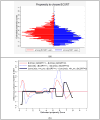ESTIMATING TREATMENT EFFECTS ON HEALTHCARE COSTS UNDER EXOGENEITY: IS THERE A 'MAGIC BULLET'?
- PMID: 22199462
- PMCID: PMC3244728
- DOI: 10.1007/s10742-011-0072-8
ESTIMATING TREATMENT EFFECTS ON HEALTHCARE COSTS UNDER EXOGENEITY: IS THERE A 'MAGIC BULLET'?
Abstract
Methods for estimating average treatment effects, under the assumption of no unmeasured confounders, include regression models; propensity score adjustments using stratification, weighting, or matching; and doubly robust estimators (a combination of both). Researchers continue to debate about the best estimator for outcomes such as health care cost data, as they are usually characterized by an asymmetric distribution and heterogeneous treatment effects,. Challenges in finding the right specifications for regression models are well documented in the literature. Propensity score estimators are proposed as alternatives to overcoming these challenges. Using simulations, we find that in moderate size samples (n= 5000), balancing on propensity scores that are estimated from saturated specifications can balance the covariate means across treatment arms but fails to balance higher-order moments and covariances amongst covariates. Therefore, unlike regression model, even if a formal model for outcomes is not required, propensity score estimators can be inefficient at best and biased at worst for health care cost data. Our simulation study, designed to take a 'proof by contradiction' approach, proves that no one estimator can be considered the best under all data generating processes for outcomes such as costs. The inverse-propensity weighted estimator is most likely to be unbiased under alternate data generating processes but is prone to bias under misspecification of the propensity score model and is inefficient compared to an unbiased regression estimator. Our results show that there are no 'magic bullets' when it comes to estimating treatment effects in health care costs. Care should be taken before naively applying any one estimator to estimate average treatment effects in these data. We illustrate the performance of alternative methods in a cost dataset on breast cancer treatment.
Figures




Similar articles
-
Improving causal inference with a doubly robust estimator that combines propensity score stratification and weighting.J Eval Clin Pract. 2017 Aug;23(4):697-702. doi: 10.1111/jep.12714. Epub 2017 Jan 24. J Eval Clin Pract. 2017. PMID: 28116816
-
Double Robust Efficient Estimators of Longitudinal Treatment Effects: Comparative Performance in Simulations and a Case Study.Int J Biostat. 2019 Feb 26;15(2):/j/ijb.2019.15.issue-2/ijb-2017-0054/ijb-2017-0054.xml. doi: 10.1515/ijb-2017-0054. Int J Biostat. 2019. PMID: 30811344 Free PMC article.
-
Model misspecification and bias for inverse probability weighting estimators of average causal effects.Biom J. 2023 Feb;65(2):e2100118. doi: 10.1002/bimj.202100118. Epub 2022 Aug 31. Biom J. 2023. PMID: 36045099 Free PMC article.
-
Sutureless Aortic Valve Replacement for Treatment of Severe Aortic Stenosis: A Single Technology Assessment of Perceval Sutureless Aortic Valve [Internet].Oslo, Norway: Knowledge Centre for the Health Services at The Norwegian Institute of Public Health (NIPH); 2017 Aug 25. Report from the Norwegian Institute of Public Health No. 2017-01. Oslo, Norway: Knowledge Centre for the Health Services at The Norwegian Institute of Public Health (NIPH); 2017 Aug 25. Report from the Norwegian Institute of Public Health No. 2017-01. PMID: 29553663 Free Books & Documents. Review.
-
Folic acid supplementation and malaria susceptibility and severity among people taking antifolate antimalarial drugs in endemic areas.Cochrane Database Syst Rev. 2022 Feb 1;2(2022):CD014217. doi: 10.1002/14651858.CD014217. Cochrane Database Syst Rev. 2022. PMID: 36321557 Free PMC article.
Cited by
-
Advance directives completion and hospital out-of-pocket expenditures.J Hosp Med. 2022 Jun;17(6):437-444. doi: 10.1002/jhm.12839. Epub 2022 May 8. J Hosp Med. 2022. PMID: 35527477 Free PMC article.
-
Evaluating treatment effectiveness under model misspecification: A comparison of targeted maximum likelihood estimation with bias-corrected matching.Stat Methods Med Res. 2016 Oct;25(5):2315-2336. doi: 10.1177/0962280214521341. Epub 2014 Feb 12. Stat Methods Med Res. 2016. PMID: 24525488 Free PMC article.
-
Impact of a statewide Emergency Department Information Exchange on health care use and expenditures.Health Serv Res. 2022 Jun;57(3):603-613. doi: 10.1111/1475-6773.13963. Epub 2022 Mar 13. Health Serv Res. 2022. PMID: 35235203 Free PMC article.
-
Impact of alternative approaches to assess outlying and influential observations on health care costs.Springerplus. 2013 Nov 18;2:614. doi: 10.1186/2193-1801-2-614. eCollection 2013. Springerplus. 2013. PMID: 24303338 Free PMC article.
-
Propensity score and doubly robust methods for estimating the effect of treatment on censored cost.Stat Med. 2016 May 30;35(12):1985-99. doi: 10.1002/sim.6842. Epub 2015 Dec 17. Stat Med. 2016. PMID: 26678242 Free PMC article.
References
-
- Abadie A, Imbens G. Large sample properties of matching estimators for average treatment effects. Econometrica. 2006;74:235–267.
-
- Altman DG. Adjustment for covariate imbalance. In: Armitage P, Colton T, editors. Encyclopaedia of Biostatistics. Wiley; New York: 1998. pp. 1000–5.
-
- Angrist J, Hahn J. When to control for covariates? Panel asymptotics for estimates of treatment effects. The Review of Economics and Statistics. 2004;86:58–72.
-
- Austin PC, Grootendorst P, Normand S-LT, Anderson GM. Conditioning on the propensity score can result in biased estimation of common measures of treatment effects, a Monte Carlo Study. Statistics in Medicine. 2007a;26:754–768. - PubMed
-
- Austin PC, Grootendorst P, Anderson GM. A comparison of the ability of different propensity score models to balance measured variables between treated and untreated subjects, a Monte Carlo study. Statistics in Medicine. 2007b;26:734–753. - PubMed
Grants and funding
LinkOut - more resources
Full Text Sources
